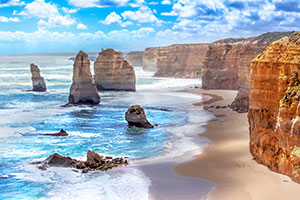12-Nights Iconic Australian Highlights & Authentic Indigenous Insights

Southern Crossings - Australia
12 nights of iconic Australian highlights and authentic Indigenous insights: ideal for first-time visitors to Australia with an interest in experiencing the world’s oldest living culture.Vacation Inclusions
- Accommodations
- Meals as noted on itinerary
- Meet and greet upon arrival
- Sightseeing and activities per the itinerary
- Private transfers and more
Featured Destinations
Lizard Island
Lizard IslandLizard Island is one of a kind - nature's amazing work of art. It is located right on the Great Barrier Reef in Australia and is a private paradise with 24 powdery white beaches just waiting to be explored. During his epic voyage of 1770, Captain James Cook climbed the peak on Lizard Island to chart a course out to sea through the maze of reefs which confronted him. Today there are many magnificent walks to be enjoyed on this island, and on at least one you can expect to glimpse a Monitor, the lizard after which the island was named. Lizard Island is renowned for its diving. At the world famous 'Cod Hole,' you can come face to face with a massive yet curious Potato Cod swimming right up to inspect you with child-like curiosity. You can also snorkel off a secluded beach to discover a garden of giant clams, some reputed to be over 120 years old. |
|
Daintree
DaintreeJust 20 minutes north of Port Douglas, Daintree is just waiting to be explored. People come from far and wide to journey through Daintree's ever-changing tropical landscape. White sandy beaches lined with palms, waving cane fields and jungle clad misty mountains are all at your fingertips. The forests of Daintree are home to an amazing array of plants, animals and insects. Keep your eyes peeled for wildlife lurking at every turn, birds flying above, butterflies floating in the air. The rainforest was added to the World Heritage List in1988 due in part because it contains such significant habitats for conservation of biological diversity. Activities include hiking trails, scenic look outs, camping, picnic tables and swimming. It is possible to take a privately owned vessel up the Daintree river, but the river is infested with crocodiles. Accommodations in Daintree range from rural cabins, farmstays, bed and breakfasts and world renown spa resorts. In the Daintree Village, you can catch a glimpse into Australia's colorful past and experience the laid back atmosphere. |
|
Brisbane
BrisbaneBrisbane Five things you should do in Brisbane: 1. Glide down the river and relax in the gardens Bike ride beneath macadamia trees and mangroves in the City Botanic Gardens or roller blade over a floating walkway. Then cruise down the river in a wooden paddle steamer, spotting pelicans and eastern water dragons. Laze or picnic under the palms on South Bank's 17 hectares of riverside gardens. Here you can swim from the lagoon and pools of Paul Breka Beach, browse the markets, visit a summer open-air cinema and dine alfresco in the sun. Follow an Aboriginal art trail through the bushland in Mount Coot-Tha Reserve, also the place to spot native wildlife and take in panoramic city views. At the foot of the mountain you can wander the tropical zone, rainforests and Japanese gardens of the Brisbane Botanic Gardens. Cuddle up to koalas and meet possums, kangaroos, wombats, emus and lyrebirds in the Lone Pine Koala Sanctuary, just a short bus drive from the city centre. 2. Soak up culture and architecture 3. Hit the water and islands of Moreton Bay 4. Eat, drink and enjoy in the urban villages 5. Embrace adventure |
Destination Guide |
Uluru
UluruThe world's largest monolith, located 280 mi/450 km southwest of Alice Springs, is a truly stunning sight, especially at sunset when its burnt-orange glow seems to set the desert on fire. Called Uluru by the Aborigines, the sandstone rock is huge (1,140 ft/350 m high, 9 mi/13 km around) and reddish brown most of the time, taking its color from iron oxide, or rust. Its presence is made more powerful by the mostly barren plain that surrounds it and disappears into the horizon. In 1985, ownership of the rock was returned to its traditional owners. It is rarely referred to as Ayers Rock anymore. Considered sacred by the Aborigines for thousands of years, the rock is now part of the expansive Uluru-Kata Tjuta National Park, one of the country's biggest tourist attractions. The park includes the Olgas/Kata Tjuta, a cluster of 36 giant domelike rock formations about 20 mi/35 km west. If you want to visit both, plan to spend at least one night. You'll want to see Uluru at both sunset and sunrise. The Olgas are equally magnificent at both times of day. (But be prepared to jockey for position at either place; tour buses disgorge hundreds of visitors laden with binoculars, cameras and video equipment.) Start your visit to the park with a stop at the cultural center. Run by the Anangu (a local Aboriginal clan), the center is a wonderful introduction to the unusual rock formations and to the people who lived in their harsh shadows for centuries. Aboriginal artwork and artifacts are on display. You can also see re-enactments of life in the bush and watch informative videos. Most visitors explore the rock as part of a tour led by park rangers, Anangu guides or private tour companies. But you can also pick up a printed walking guide at the cultural center and set off on your own. Only one trail leads to the top of the rock, and it's fairly steep—those with heart conditions, high blood pressure, asthma, fear of heights or the like should remain earthbound. The Anangu prefer you walk around—not on—the rock because of its spiritual importance. If you do decide to climb it, allow two to three hours and take along a snack and plenty of water. The view from the top is spectacular, but hiking around the base is more educational and less strenuous. We suggest taking one or more of the shorter walks that pass water holes and rock paintings, allowing you to observe the rock's many faces at a leisurely pace. (Walking around the entire base of the rock takes about three hours.) Allow at least an afternoon to visit the Olgas/Kata Tjuta. A frequent debate among visitors is whether the Olgas outshine the rock. It's a close call—the Olgas are taller, reaching 1,790 ft/545 m at the highest point. Made of conglomerate (pebbles and boulders cemented together by mud and sand), they are off-limits to climbers, but you can explore some of the valleys and chasms between the rocks. Most visitors fly to Uluru or drive from Alice Springs. About the only place to stay in the area is the Ayers Rock Resort, or Yulara, whose five hotels and a campground can accommodate visitors in all price ranges. Longitude 131 is a magnificent safari camp with 15 luxury tents. Dozens of tours leave from Ayers Rock Resort, including sunrise camel rides around the rock, sunset champagne dinners in the desert, Aboriginal culture tours and stargazing. You can also rent a car there and explore on your own. Because of the excessive heat in summer, the best time to visit is April-November (winter in Australia). Always take along plenty of drinking water. If you are flying to the Outback, we suggest going overland one way from Alice Springs (four to five hours) but flying the other way—the desert drive is scenic, but it can be tedious the second time around. http://www.environment.gov.au/parks/uluru. |
Destination Guide |
Sydney
SydneySydney Five Sydney Experiences Not to Miss: 1. Explore the historic Rocks 2. Hit the world-famous harbour 3. Visit Manly on the ferry 4. Enjoy café culture and top shopping in Paddington 5. Walk from Bondi to Coogee |
Destination Guide |
Valid Date Ranges
-
January 2025
01/16/2025 12/31/2025 Call for pricing
All fares are quoted in US Dollars.





